Next Bundle
How has Next Company Dominated the Retail Landscape?
Next plc, a retail giant, has masterfully adapted its sales and marketing strategies to thrive in a fiercely competitive market. From its roots as a tailoring business in 1864 to its current status as a technology-driven leader, Next's evolution is a testament to its strategic prowess. This journey, marked by innovative approaches and a keen understanding of consumer behavior, has propelled the company to the forefront of the UK retail sector.
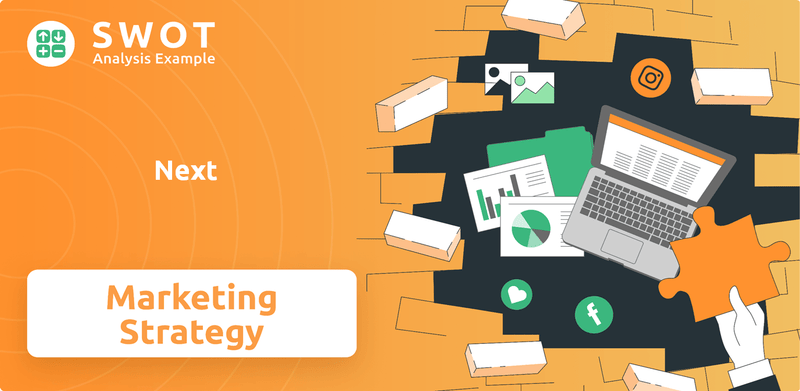
This exploration delves into the Next SWOT Analysis, its go-to-market strategy, and how Next Company aligns its sales and marketing efforts. We'll examine the core elements of its business strategy, including its sales strategy, marketing strategy, and customer acquisition strategy. Understanding Next's approach offers valuable insights into best practices for sales strategy and implementing a marketing strategy in the dynamic digital age.
How Does Next Reach Its Customers?
The sales strategy of Next Company is built on a multi-channel approach, integrating both online and offline channels to reach a wide customer base. This strategy includes physical retail stores, a comprehensive e-commerce platform, and the Next Directory, a catalogue business. This blend allows Next to cater to various customer preferences and shopping behaviors.
Next's marketing strategy has evolved over time, adapting to digital advancements. The company's early adoption of e-commerce, starting in 1999, has been crucial to its growth. The integration of online and offline channels has also been a key component of Next's business strategy, enhancing customer experience and driving sales.
As of late 2023, Next had around 550 retail stores in the UK and Ireland, along with approximately 200 franchised stores across Europe, Asia, and the Middle East. The company's online sales strategy continues to be a major driver of revenue, with UK online sales increasing by 3% in the fiscal year ending January 2024, and total online revenue reaching £2.54 billion. Physical stores remain important, with nearly half of UK online orders collected in-store, demonstrating an effective omnichannel integration.
Next operates a significant number of retail stores across the UK, Ireland, and through franchises internationally. These stores provide a physical presence where customers can browse products and make purchases. The physical stores play a vital role in Next's overall sales and marketing strategy.
The company's e-commerce platform, accessible via next.co.uk, is a key sales channel. It provides customers with a convenient way to shop online, contributing significantly to Next's revenue. The online platform's growth reflects the company's effective digital marketing strategy.
The Next Directory, a catalogue business, has historically been a significant sales channel. It laid the groundwork for the company's online presence. The catalogue continues to support sales, particularly for customers who prefer to browse products offline.
Partnerships and exclusive distribution deals have contributed to Next's growth. The company has acquired stakes in fashion retailers and entered into joint ventures. This strategy allows Next to expand its product offerings and reach new customer segments.
Next's business strategy includes strategic partnerships and acquisitions to grow its market presence. The company has expanded its reach through ventures like the 'Total Platform,' providing e-commerce solutions to third-party brands. This approach allows Next to generate revenue beyond its own product lines, demonstrating a robust sales and marketing alignment.
- Next has acquired stakes in fashion retailers like Reiss, increasing its shareholding to 51%.
- The 'Total Platform' provides e-commerce solutions to brands such as Childsplay Clothing, Reiss, and JoJo Maman Bébé.
- International expansion includes selling via third-party aggregators and opening local distribution hubs.
- For more information on the target market, please read this article about the Target Market of Next.
Next SWOT Analysis
- Complete SWOT Breakdown
- Fully Customizable
- Editable in Excel & Word
- Professional Formatting
- Investor-Ready Format
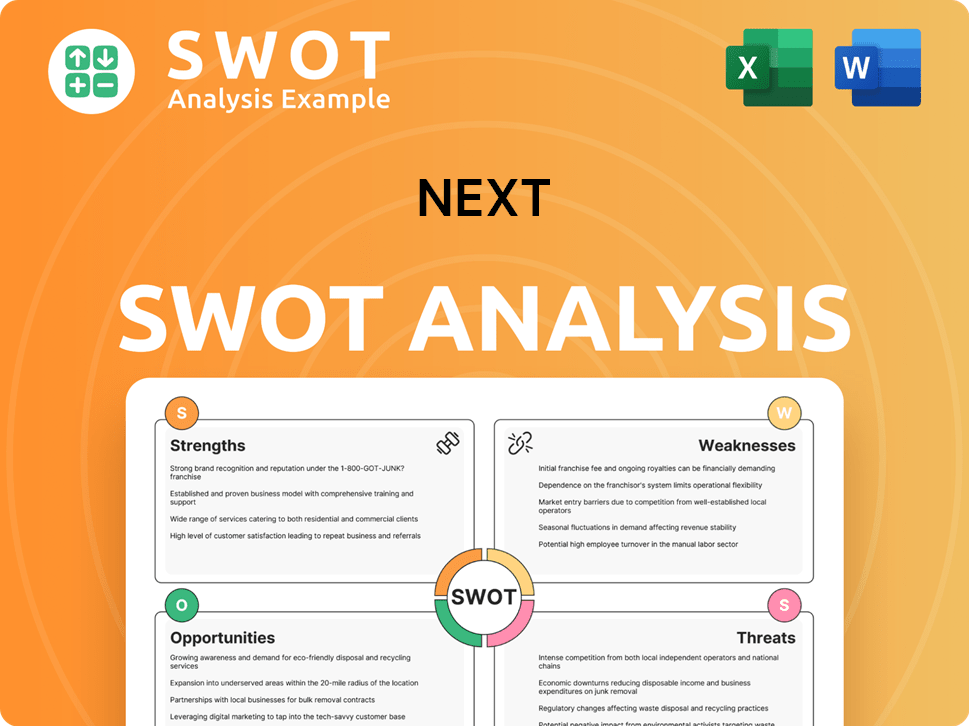
What Marketing Tactics Does Next Use?
The company employs a comprehensive marketing strategy, blending digital and traditional tactics to boost brand recognition, generate leads, and drive sales. Digital marketing is a key focus, recognized as both a growing expense and an opportunity for the brand. The company leverages content marketing, paid advertising, email marketing, and social media to engage with its audience.
The company is particularly focused on improving the effectiveness of its digital marketing efforts. This includes developing digital marketing systems to target products and brands to customers and incorporating sophisticated search facilities and web-based marketing tools linked to email and social marketing systems. The company's approach emphasizes data-driven decision-making, with a strong focus on measuring the return on investment (ROI) of its marketing activities.
The company aims to maximize the growth of successful activities and quickly move on from those that fail. The company's strategy also involves enhancing its website functionality and delivery services to improve customer experience and drive online sales, reflecting its commitment to adapting to evolving consumer behaviors and preferences.
The company heavily invests in digital marketing, recognizing it as both a cost and an opportunity. This includes content marketing, paid advertising, and social media engagement. The goal is to enhance the effectiveness of digital channels.
Email marketing likely aligns with 2025 trends, emphasizing AI-driven personalization. This includes AI-generated email copies and hyper-personalized content. AI is expected to drive more relevant and visually appealing messages.
The company uses a data-driven approach to marketing, rigorously controlling costs. It employs a 'hurdle rate' approach to marketing spend, investing only if a certain ROI is achieved. This ensures efficient allocation of resources.
The company focuses on improving website functionality and delivery services. This aims to enhance the customer experience and boost online sales. These improvements are crucial for adapting to changing consumer behaviors.
The company aims to maximize the growth of successful activities. It quickly adapts by moving away from those that fail. This agile approach ensures resources are efficiently allocated.
Overall marketing expenditure is expected to increase as a percentage of sales, particularly in 'new and developing channels' in the UK. This reflects the increasing effectiveness of these channels.
The company's marketing strategy is designed to be adaptable and responsive to market trends. The focus on digital channels, data-driven decision-making, and customer experience improvements positions the company to effectively compete in the evolving retail landscape. Understanding the Owners & Shareholders of Next can also provide insights into the company's strategic direction and financial goals.
The company's marketing tactics are multifaceted, encompassing digital and traditional methods. The emphasis is on data-driven decisions and continuous improvement. Key strategies include:
- Digital Marketing: Content marketing, paid advertising, email marketing, and social media.
- Email Marketing: Leveraging AI for personalization and automation.
- Data-Driven Approach: Rigorous cost control and ROI-focused investment.
- Website and Delivery: Enhancing functionality to improve customer experience.
- Adaptability: Quickly scaling successful activities and adjusting strategies.
Next PESTLE Analysis
- Covers All 6 PESTLE Categories
- No Research Needed – Save Hours of Work
- Built by Experts, Trusted by Consultants
- Instant Download, Ready to Use
- 100% Editable, Fully Customizable
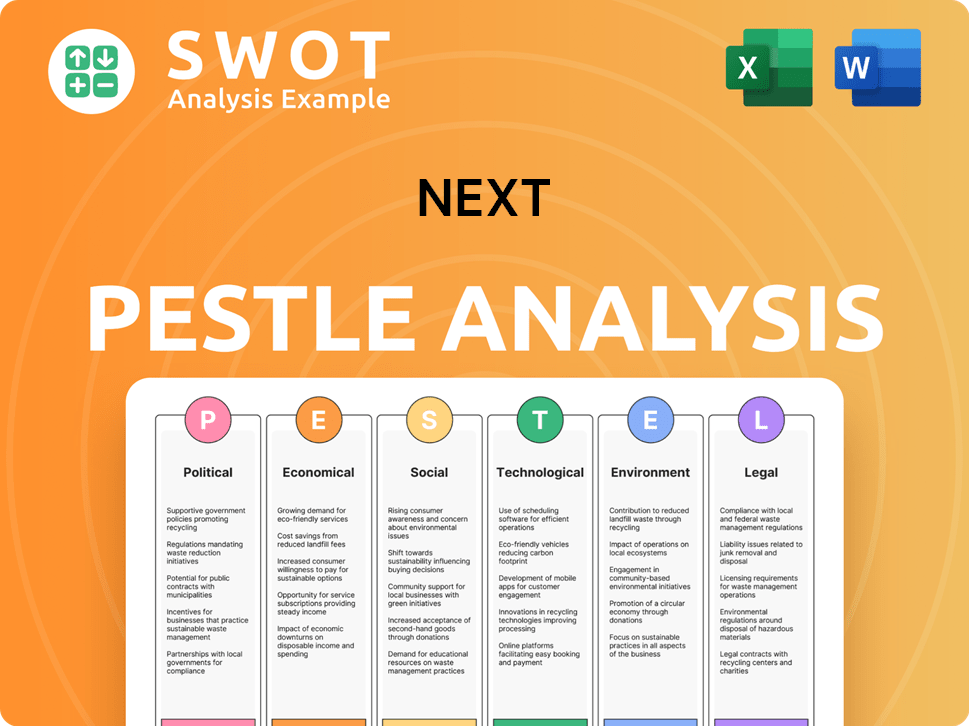
How Is Next Positioned in the Market?
Next plc, a British multinational retailer, strategically positions itself to be a leading provider of clothing, footwear, and home products. Its brand identity, rooted in its 1982 origins, blends heritage with modern retail demands, aiming to be the preferred choice for customers and a profitable partner for third-party brands. This approach is central to its overall business strategy and influences its sales strategy and marketing strategy.
The company differentiates itself through a focus on design, quality, and accessibility, supported by a strong omnichannel presence. Next's goal is to offer beautifully designed, high-quality products at accessible prices, catering to a broad customer base. This is crucial for its go-to-market strategy and maintaining a competitive edge in the retail sector.
Despite fluctuations in brand perception metrics, as indicated by YouGov's BrandIndex in early 2024, Next's focus remains on delivering what customers desire. This customer-centric approach is evident in its product offerings and the evolution of its brand to meet changing consumer preferences. For a deeper understanding of Next's financial model, consider reading about the Revenue Streams & Business Model of Next.
Next emphasizes design, quality, and accessibility in its product offerings. These values are consistently reflected across all channels, from physical stores to online platforms.
The company integrates physical stores with online services, such as handling a significant portion of online returns. This integration ensures a consistent customer experience.
Next targets a broad audience seeking fashion and home products. It aims to be the first choice for its core customer base and a profitable partner for third-party brands.
Next adapts to consumer trends by evolving its product offerings. The launch of 'Seasons' in 2024 showcases this, catering to customers interested in 'affordable luxury.'
Next Business Model Canvas
- Complete 9-Block Business Model Canvas
- Effortlessly Communicate Your Business Strategy
- Investor-Ready BMC Format
- 100% Editable and Customizable
- Clear and Structured Layout
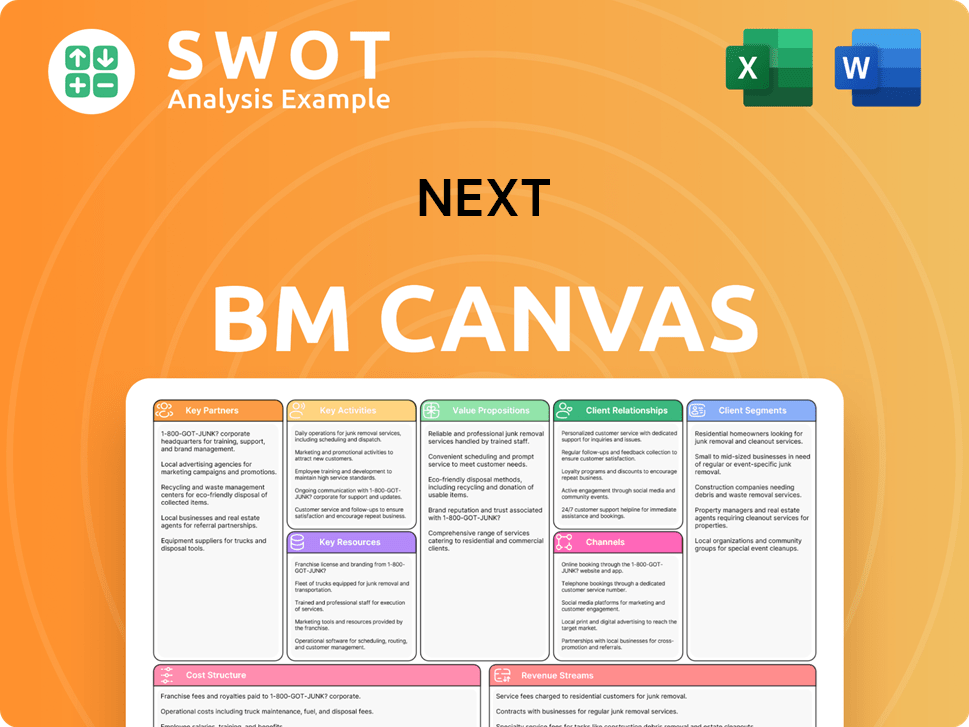
What Are Next’s Most Notable Campaigns?
The focus of the sales and marketing strategy for Next Company centers on campaigns that drive revenue growth and enhance brand visibility. While specific details on recent campaigns are not extensively publicized, the company's strategic direction and financial performance offer insights into its marketing initiatives. Next is increasing its marketing spend, particularly in 'new and developing channels' within the UK, indicating a commitment to campaigns that demonstrate a strong return on investment.
A significant historical 'campaign' for Next was the launch of the Next Directory in 1988, which revolutionized home shopping and set a blueprint for catalogue retailing. This initiative expanded Next's reach and established its direct-to-consumer model, enabling its transition to e-commerce. Next's overall approach highlights a commitment to innovation and adapting to changing consumer behaviors, crucial elements in a robust sales strategy.
In more recent times, Next's 'Total Platform' initiative is a key business development campaign. Launched in 2020, this platform provides comprehensive e-commerce solutions to third-party brands, contributing to strong financial performance. The success of this platform, including partnerships with brands like Reiss and Joules, demonstrates Next's effective go-to-market strategy and its ability to leverage its existing infrastructure for growth. The company's focus on online sales growth, with UK online sales increasing by 3% and total online revenue reaching £2.54 billion in the fiscal year ending January 2024, underscores the effectiveness of its digital marketing efforts.
The launch of the Next Directory in 1988 was a pivotal campaign, transforming the company's sales approach. This initiative expanded the company's reach and established a direct-to-consumer model. This strategic move laid the foundation for future e-commerce endeavors, showcasing a forward-thinking business strategy.
Launched in 2020, the 'Total Platform' initiative is a key business development campaign. This platform provides e-commerce solutions to third-party brands, contributing to Next's robust financial performance. Partnerships with brands like Reiss and Joules highlight the success of this go-to-market strategy.
Next's strong online sales growth, with UK online sales up by 3% and total online revenue reaching £2.54 billion in the fiscal year ending January 2024, is a testament to effective digital marketing. Ongoing improvements to online services drive customer acquisition strategy and engagement. This success is a key component of the company's overall sales strategy.
Collaborations with brands like Gap and Victoria's Secret, through joint ventures, demonstrate a strategy of leveraging partnerships. These partnerships boost brand visibility and credibility, contributing to Next's overall marketing strategy. This approach supports a broader business strategy focused on brand diversification and market expansion.
Next's sales and marketing strategy is characterized by a blend of historical innovation and a focus on digital channels and strategic partnerships. The company's financial performance reflects the success of these initiatives, with projected revenue of £6.50 billion for 2025-26. This demonstrates a commitment to continuous improvement and adaptation. To understand more about the history of the company, you can read the Brief History of Next.
Next Porter's Five Forces Analysis
- Covers All 5 Competitive Forces in Detail
- Structured for Consultants, Students, and Founders
- 100% Editable in Microsoft Word & Excel
- Instant Digital Download – Use Immediately
- Compatible with Mac & PC – Fully Unlocked
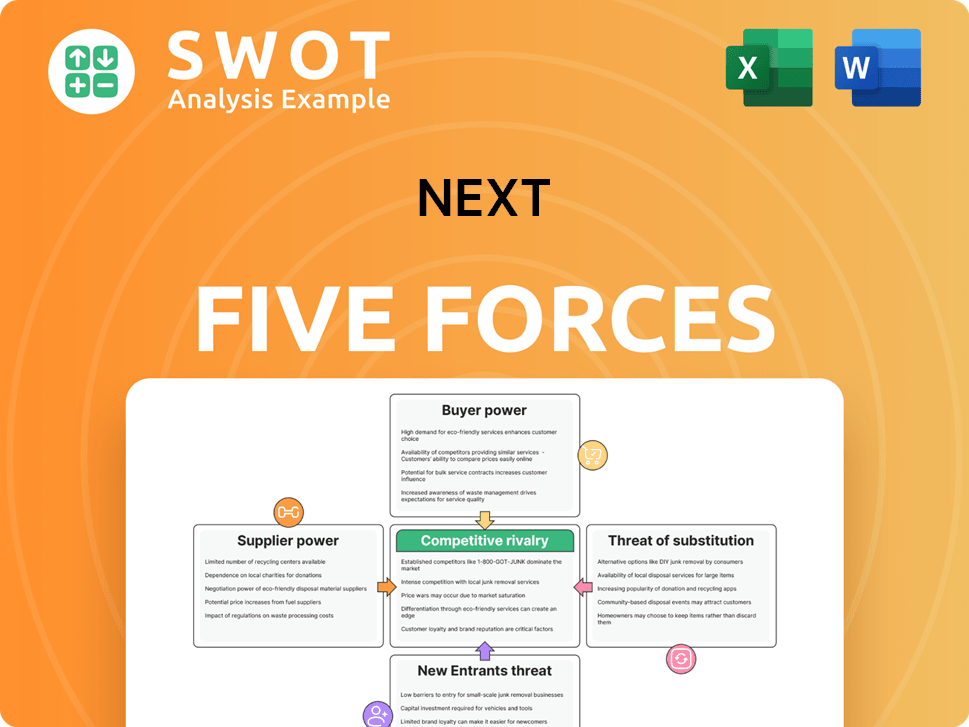
Related Blogs
- What are Mission Vision & Core Values of Next Company?
- What is Competitive Landscape of Next Company?
- What is Growth Strategy and Future Prospects of Next Company?
- How Does Next Company Work?
- What is Brief History of Next Company?
- Who Owns Next Company?
- What is Customer Demographics and Target Market of Next Company?
Disclaimer
All information, articles, and product details provided on this website are for general informational and educational purposes only. We do not claim any ownership over, nor do we intend to infringe upon, any trademarks, copyrights, logos, brand names, or other intellectual property mentioned or depicted on this site. Such intellectual property remains the property of its respective owners, and any references here are made solely for identification or informational purposes, without implying any affiliation, endorsement, or partnership.
We make no representations or warranties, express or implied, regarding the accuracy, completeness, or suitability of any content or products presented. Nothing on this website should be construed as legal, tax, investment, financial, medical, or other professional advice. In addition, no part of this site—including articles or product references—constitutes a solicitation, recommendation, endorsement, advertisement, or offer to buy or sell any securities, franchises, or other financial instruments, particularly in jurisdictions where such activity would be unlawful.
All content is of a general nature and may not address the specific circumstances of any individual or entity. It is not a substitute for professional advice or services. Any actions you take based on the information provided here are strictly at your own risk. You accept full responsibility for any decisions or outcomes arising from your use of this website and agree to release us from any liability in connection with your use of, or reliance upon, the content or products found herein.